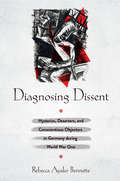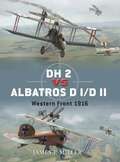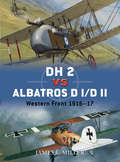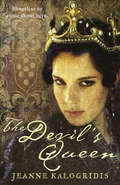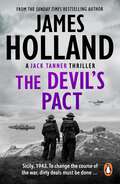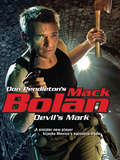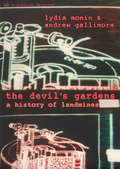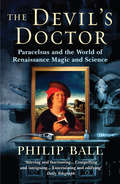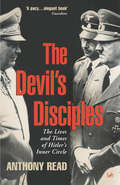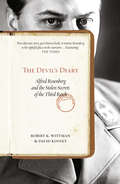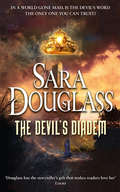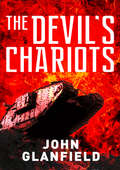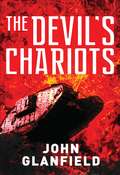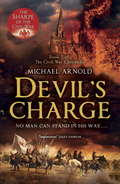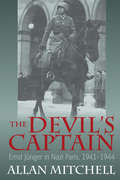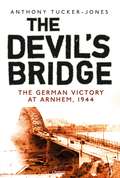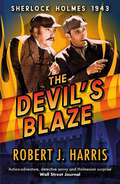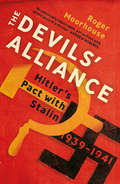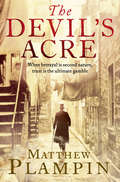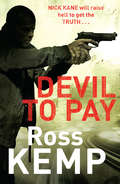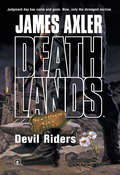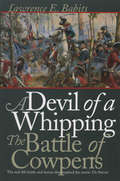- Table View
- List View
Diagnosing Dissent: Hysterics, Deserters, and Conscientious Objectors in Germany during World War One
by Rebecca Ayako BennetteAlthough physicians during World War I, and scholars since, have addressed the idea of disorders such as shell shock as inchoate flights into sickness by men unwilling to cope with war's privations, they have given little attention to the agency many soldiers actually possessed to express dissent in a system that medicalized it. In Germany, these men were called Kriegszitterer, or "war tremblers," for their telltale symptom of uncontrollable shaking. Based on archival research that constitutes the largest study of psychiatric patient files from 1914 to 1918, Diagnosing Dissent examines the important space that wartime psychiatry provided soldiers expressing objection to the war.Rebecca Ayako Bennette argues that the treatment of these soldiers was far less dismissive of real ailments and more conducive to individual expression of protest than we have previously thought. In addition, Diagnosing Dissent provides an important reevaluation of German psychiatry during this period. Bennette's argument fundamentally changes how we interpret central issues such as the strength of the German Rechtsstaat and the continuities or discontinuities between the events of World War I and the atrocities committed—often in the name of medicine and sometimes by the same physicians—during World War II.
DH 2 vs Albatros D I/D II: Western Front 1916 (Duel #42)
by Jim Laurier Mark Postlethwaite James F. MillerFlown by Victoria Cross recipient Lanoe Hawker and the members of No 24 Sqn, the ungainly yet nimble DH 2 helped the Allies attain air superiority over the Somme in early 1916 and hold it through the summer. With its rotary engine 'pusher' configuration affording excellent visibility and eliminating the need for a synchronized machine gun, the DH 2 was more than a match for anything the Germans could put in the air. That is, until the arrival of the Albatros D II, a sleek inline-engined machine built for speed and with twin-gun firepower. Thus, the later part of 1916 saw an epic struggle in the skies above the Somme pitting the manoeuvrable yet under-gunned DH 2s against the less nimble yet better armed and faster Albatros D IIs. In the end the Germans would regain air superiority, three squadron commanders – two of whom were considered pinnacles of their respective air forces – would lose their lives, and an up-and-coming pilot (Manfred von Richthofen) would triumph in a legendary dogfight and attain unimagined heights fighting with tactics learned from a fallen mentor.
DH 2 vs Albatros D I/D II: Western Front 1916 (Duel #42)
by Jim Laurier Mr Mark Postlethwaite James F. MillerFlown by Victoria Cross recipient Lanoe Hawker and the members of No 24 Sqn, the ungainly yet nimble DH 2 helped the Allies attain air superiority over the Somme in early 1916 and hold it through the summer. With its rotary engine 'pusher' configuration affording excellent visibility and eliminating the need for a synchronized machine gun, the DH 2 was more than a match for anything the Germans could put in the air. That is, until the arrival of the Albatros D II, a sleek inline-engined machine built for speed and with twin-gun firepower. Thus, the later part of 1916 saw an epic struggle in the skies above the Somme pitting the manoeuvrable yet under-gunned DH 2s against the less nimble yet better armed and faster Albatros D IIs. In the end the Germans would regain air superiority, three squadron commanders – two of whom were considered pinnacles of their respective air forces – would lose their lives, and an up-and-coming pilot (Manfred von Richthofen) would triumph in a legendary dogfight and attain unimagined heights fighting with tactics learned from a fallen mentor.
Devotion: An Epic Story of Heroism, Brotherhood and Sacrifice
by Adam MakosThe new book from the author of A Higher Call (a Sunday Times bestseller) tells the overwhelming true story of the most incredible rescue mission you will ever read.Devotion is the gripping story of the US Navy's most famous aviator duo - Tom Hudner, a white, blue-blooded New Englander, and Jesse Brown, a black sharecropper's son from Mississippi. Against all odds, Jesse beat back racism to become the Navy's first black aviator. Against all expectations, Tom passed up a free ride at Harvard to fly fighter planes for his country. Barely a year after President Truman ordered the desegregation of the military, the two became wingmen in Fighter Squadron 32 and went on to fight side-by-side in the Korean War. In the war's climatic battle at the Chosin Reservoir, Tom and Jesse flew headlong into waves of troops in order to defend an entire division of Marines trapped on a frozen lake. Jesse was shot down and pinned in the burning wreckage of his fighter. Tom then faced an unthinkable choice - to see his friend burn to death or to go down in a blaze of glory, flouting the rules to crash-land behind enemy lines and save Jesse - or die trying. The question was crueller than the freezing wind: How far will you go to save a friend?
The Devil’s Queen: A Novel Of Catherine De Medici
by Jeanne KalogridisA compelling tale of love, lust and murder which traces the evolution of Catherine de Medici – the great-granddaughter of Lorenzo the Magnificent – from an unloved, timid orphan to France's most cunning monarch
The Devil's Pact: (Jack Tanner: book 5): a blood-pumping, edge-of-your-seat wartime thriller guaranteed to have you hooked… (Jack Tanner #5)
by James HollandSicily, 1943 - to fight the Nazi rearguard, old foes like the Mafia must become new friends for Jack Tanner and his crew...July 1943: with North Africa secured, the Allies launch an invasion of Sicily, and the 2nd Battalion, King’s Own Yorkshire Rangers are in the vanguard of the assault on the Italian beaches.But promotion to Company Commander has brought fresh trouble for Jack Tanner. Not only has his new Battalion Commander decided to make his life as difficult as possible, they soon find themselves battling against some of the toughest, most determined troops in the Wehrmacht.In the bitter fighting that follows, Tanner witnesses a new reality. Forced to question the cause for which they have fought so long, Tanner and his trusted sidekick, Sykes, find themselves embroiled in a deeply personal fight, in which they have to use all their resolve, skill and experience if they are to stand any chance of survival…
Devil's Mark
by Don PendletonTrouble on the U.S. border with Mexico puts Mack Bolan in the middle of a DEA counter-narcotics operation that's been compromised in the worst way.
The Devil's Gardens: The Story of Landmines
by Lydia Monin'The image I have is a kid on a country lane on a Saturday afternoon herding his family cattle, meaning no harm to anybody and putting one step wrong. It's one thing to die in combat, it's one thing to die defending land, but it's another thing to die tending cattle on a Saturday afternoon and we want a world where that doesn't happen' - Michael IgnatieffDuring the twentieth century a landmine plague raged across the globe. It began on the battlefields of two world wars, it gathered momentum in Korea and Vietnam and then spread like wildfire throughout the developing world. The Devil's Gardens is the definitive story of the landmine. It is the story of the development and proliferation of a weapon of terror. It is also the story of suffering and devastation, and a worldwide crusade to put an end to the curse of landmines forever. The issues surrounding landmines and their continued use are controversial. Drawing on a wide range of distinguished interviewees and the authors' first-hand experiences in severely mine-affected countries, The Devil's Gardens look at all sides of the landmine story.
The Devil's Doctor: Paracelsus and the World of Renaissance Magic and Science
by Philip BallPhilip Theophrastus Aureolus Bombastus von Hohenheim - known to later ages as Paracelsus - stands on the borderline between medieval and modern; a name that is familiar but a man who has been hard to perceive or understand. Contemporary of Luther, enemy of established medicine, scourge of the universities ('at all the German schools you cannot learn as much as at the Frankfurt Fair'), army surgeon and alchemist, myths about him - from his treating diseases from beyond the grave in mid-nineteenth century Salzburg to his Faustian bargain with the devil to regain his youth - have been far more lasting than his actual story. Even during his lifetime, he was rumoured to travel with a magical white horse and to store the elixir of life in the pommel of his sword.But who was Paracelsus and what did he really believe and practice? Although Paracelsus has been seen as both a charlatan and as a founder of modern science, Philip Ball's book reveals a more richly complex man - who used his eyes and ears to learn from nature how to heal, and who wrote influential books on medicine, surgery, alchemy and theology while living a drunken, combative, vagabond life. Above all, Ball reveals a man who was a product of his time - an age of great change in which the church was divided and the classics were rediscovered - and whose bringing together of the seemingly diverse disciplines of alchemy and biology signalled the beginning of the age of rationalism.
The Devil's Disciples: The Life And Times Of Hitler's Inner Circle
by Anthony ReadThe Nazi regime was essentially a religious cult, relying on the hypnotic personality of one man, Adolf Hitler, and it was fated to die with him. But while it lasted, his closest lieutenants competed ferociously for power and position as his chosen successor. This deadly contest accounted for many of the regime's worst excesses, in which millions of people died, and which brought Western civilization to its knees. The Devil's Disciples is the first major book for a general readership to examine those lieutenants, not only as individuals but also as a group. It focuses on the three Nazi paladins closest to Hitler - Goring, Goebbels and Himmler - with their nearest rivals - Bormann, Speer and Ribbentrop in close attendance. Others who were removed in various ways - like Gregor Strasser, Ernst R-hm, Heydrich and Hess - play supporting roles. Perceptive and illuminating, The Devil's Disciples is above all a powerful chronological narrative, showing how the personalities of Hitler's inner circle developed and how their jealousies and constant intrigues affected the regime, the war, and Hitler himself.
The Devil’s Diary: Alfred Rosenberg And The Stolen Secrets Of The Third Reich
by Robert K Wittman David KinneyAn unprecedented, page-turning narrative of the Nazi rise to power, the Holocaust, and Hitler’s post-invasion plans for Russia told through the recently discovered lost diary of Alfred Rosenberg – Hitler’s ‘philosopher’ and architect of Nazi ideology.
The Devil’s Diadem
by Sara DouglassSara Douglass has won legions of fans around the world for her epic tales of sorcery, forbidden love, and heart-pounding action. Now, with the The Devil’s Diadem, she reveals her biggest adventure yet.
The Devil’s Chariots: The origins and secret battles of tanks in the First World War
by John GlanfieldThis scholarly and clear-sighted book … is a happy marriage of history and technology and deserves to become standard reading for serious students of the First World War.' Prof. Richard Holmes 'Fascinating. Excellent pictures and a readable text as well. A wonderful story well told.' Military Illustrated 'The Devil's Chariots is the best single work on the development, from concept to fielding, of British armour in the First World War… Glanfield is also entertaining in addition to being enlightening… The Devil's Chariots is a decent read, and for specialists in the field it will be required reading… The research is both broad and solid, and it appears that this will be the last word on this topic for some time to come.' Robert L. Bateman, contributor to The Journal of Military History, Lexington VA, and a member of the Society for Military History 'This book is in a class of its own … it brings a new maturity to the study of the tank, most particularly from the human perspective, and best of all, it is very readable'. David Fletcher, Senior Archivist, Tank Museum, Bovington, author of The Tank 'This volume would be a great addition to the library of anyone wishing to try to understand World War 1 better. I greatly enjoyed this evidently well-researched and highly interesting book… It taught me much. I am grateful.' Royal Naval Sailing Association Journal 'Fascinating … all military procurement officers should read it… All this is excellently set out, especially the people who made [the tank weapon] possible and those who resented such new ideas.' Brig Fraser Scott, contributor to The Journal of the Royal Artillery Institution 'John Glanfield sheds new light on the tank's pioneers, their bizarre experimental machines and later triumphs… This intensely researched work … is drawn from previously unpublished primary sources.' Gun Mart 'This is classic research by a world authority.' The Driffield Post 'The author has a sharp eye for detail … an exemplary history of a pivotal aspect of the First World War.' Worcester Evening News 'The Devil's Chariots can fairly claim to be the most intensively researched and detailed account of the tank's origins yet to appear.' Classic Arms & Militaria 'John Glanfield has combined meticulous historical research with a gift for narrative to present a story that both students of the Great War and the general reader will find fascinating. I thoroughly recommend this book.' John Gregory, contributor to The Journal of the Henry Williamson Society The Devil's Chariot is the product of six years of research by author John Glanfield, who wanted to tell the story of the birth of the tank in World War I, and, importantly, the men behind it. Based on personal recollections and official reports Glanfield uncovers the British tank pioneers and their odd machines, the men who supported the new weapon, those who refused to accept their worth and the brave crews who took them into battle.
The Devil’s Chariots: The origins and secret battles of tanks in the First World War
by John GlanfieldThis scholarly and clear-sighted book … is a happy marriage of history and technology and deserves to become standard reading for serious students of the First World War.' Prof. Richard Holmes 'Fascinating. Excellent pictures and a readable text as well. A wonderful story well told.' Military Illustrated 'The Devil's Chariots is the best single work on the development, from concept to fielding, of British armour in the First World War… Glanfield is also entertaining in addition to being enlightening… The Devil's Chariots is a decent read, and for specialists in the field it will be required reading… The research is both broad and solid, and it appears that this will be the last word on this topic for some time to come.' Robert L. Bateman, contributor to The Journal of Military History, Lexington VA, and a member of the Society for Military History 'This book is in a class of its own … it brings a new maturity to the study of the tank, most particularly from the human perspective, and best of all, it is very readable'. David Fletcher, Senior Archivist, Tank Museum, Bovington, author of The Tank 'This volume would be a great addition to the library of anyone wishing to try to understand World War 1 better. I greatly enjoyed this evidently well-researched and highly interesting book… It taught me much. I am grateful.' Royal Naval Sailing Association Journal 'Fascinating … all military procurement officers should read it… All this is excellently set out, especially the people who made [the tank weapon] possible and those who resented such new ideas.' Brig Fraser Scott, contributor to The Journal of the Royal Artillery Institution 'John Glanfield sheds new light on the tank's pioneers, their bizarre experimental machines and later triumphs… This intensely researched work … is drawn from previously unpublished primary sources.' Gun Mart 'This is classic research by a world authority.' The Driffield Post 'The author has a sharp eye for detail … an exemplary history of a pivotal aspect of the First World War.' Worcester Evening News 'The Devil's Chariots can fairly claim to be the most intensively researched and detailed account of the tank's origins yet to appear.' Classic Arms & Militaria 'John Glanfield has combined meticulous historical research with a gift for narrative to present a story that both students of the Great War and the general reader will find fascinating. I thoroughly recommend this book.' John Gregory, contributor to The Journal of the Henry Williamson Society The Devil's Chariots is the product of six years of research by author John Glanfield, who wanted to tell the story of the birth of the tank in World War I, and, importantly, the men behind it. Based on personal recollections and official reports Glanfield uncovers the British tank pioneers and their odd machines, the men who supported the new weapon, those who refused to accept their worth and the brave crews who took them into battle.
Devil's Charge: Book 2 of The Civil War Chronicles (Stryker)
by Michael ArnoldDevil's Charge, the second in The Civil War Chronicles, Michael Arnold's acclaimed series of historical thrillers, sees battle-scarred hero Captain Stryker, 'the Sharpe of the Civil War', fight for his honour. 'Stands in comparison with the best of Cornwell' Yorkshire PostEngland stands divided: king against Parliament, town against country, brother against brother. For Captain Stryker, scarred hero of a dozen wars, the rights and wrongs of the cause mean little. His loyalties are to his own small band of comrades - and to Queen Henrietta Maria's beautiful and most deadly agent, Lisette Gaillard. So when Prince Rupert entrusts him with a secret mission to discover what has happened to Lisette and the man she was protecting - a man who could hold the key to Royalist victory - nothing, not false imprisonment for murder, ambush, a doomed siege or a lethal religious fanatic will stand in his way.A Sunday Times Historical Fiction Book of the Year
The Devil's Captain: Ernst Jünger in Nazi Paris, 1941-1944
by Allan MitchellAuthor of Nazi Paris, a Choice Academic Book of the Year, Allan Mitchell has researched a companion volume concerning the acclaimed and controversial German author Ernst Jünger who, if not the greatest German writer of the twentieth century, certainly was the most controversial. His service as a military officer during the occupation of Paris, where his principal duty was to mingle with French intellectuals such as Jean Cocteau and with visiting German celebrities like Martin Heidegger, was at the center of disputes concerning his career. Spending more than three years in the French capital, he regularly recorded in a journal revealing impressions of Parisian life and also managed to establish various meaningful social contacts, with the intriguing Sophie Ravoux for one. By focusing on this episode, the most important of Jünger’s adult life, the author brings to bear a wide reading of journals and correspondence to reveal Jünger’s professional and personal experience in wartime and thereafter. This new perspective on the war years adds significantly to our understanding of France's darkest hour.
The Devil's Bridge: The German Victory at Arnhem, 1944
by Anthony Tucker-JonesIn the late summer of 1944, SS-Obergruppenführer Wilhelm 'Willi' Bittrich found himself in the Netherlands surveying his II SS Panzer Corps, which was in a poor state having narrowly escaped the defeat in Normandy. He was completely unaware that his command lay directly in the path of a major Allied thrust: the 17 September 1944 launch of the largest airborne and glider operation in the history of warfare. Codenamed Operation Market Garden, it was intended to outflank the German West Wall and 'bounce' the Rhine at Arnhem, from where the Allies could strike into the Ruhr, Nazi Germany's industrial heartland. Such a move could have ended the war. However, Market Garden and the battle for Arnhem were a disaster for the Allies. Put together in little over a week and lacking in flexibility, the operation became an all-or-nothing race against time. The plan to link the airborne divisions by pushing an armoured division up a sixty-five-mile corridor was optimistic at best, and the British drop zones were not only too far from Arnhem Bridge, but also directly above two recuperating SS Panzer divisions. This new book explores the operation from the perspective of the Germans as renowned historian Anthony Tucker-Jones examines how they were able to mobilise so swiftly and effectively in spite of depleted troops and limited intelligence.
The Devil's Bridge: The German Victory at Arnhem, 1944
by Anthony Tucker-JonesIn the late summer of 1944, SS-Obergruppenführer Wilhelm 'Willi' Bittrich found himself in the Netherlands surveying his II SS Panzer Corps, which was in a poor state having narrowly escaped the defeat in Normandy. He was completely unaware that his command lay directly in the path of a major Allied thrust: the 17 September 1944 launch of the largest airborne and glider operation in the history of warfare. Codenamed Operation Market Garden, it was intended to outflank the German West Wall and 'bounce' the Rhine at Arnhem, from where the Allies could strike into the Ruhr, Nazi Germany's industrial heartland. Such a move could have ended the war. However, Market Garden and the battle for Arnhem were a disaster for the Allies. Put together in little over a week and lacking in flexibility, the operation became an all-or-nothing race against time. The plan to link the airborne divisions by pushing an armoured division up a sixty-five-mile corridor was optimistic at best, and the British drop zones were not only too far from Arnhem Bridge, but also directly above two recuperating SS Panzer divisions. This new book explores the operation from the perspective of the Germans as renowned historian Anthony Tucker-Jones examines how they were able to mobilise so swiftly and effectively in spite of depleted troops and limited intelligence.
The Devil's Blaze: Sherlock Holmes: 1943 (Sherlock's War #2)
by Robert J. HarrisThe world’s greatest detective returns.London, 1943.Across the city prominent figures in science and the military are bursting into flame and being incinerated. Convinced that the Germans have deployed a new terror weapon, a desperate government turns to the one man who can track down the source of this dreadful menace - Sherlock Holmes.The quest for a solution drives Holmes into an uneasy alliance with the country’s most brilliant scientific genius, Professor James Moriarty. Only Holmes knows that, behind his façade of respectability, Moriarty is the mastermind behind a vast criminal empire. As they pursue the trail of incendiary murders, Holmes is quite sure that the professor is playing a double game and that there lies ahead a duel to the death which they cannot both survive.
The Devil's Anvil: The Assault on Peleliu
by James H. HallasOn September 15, 1944, General William Rupertus and the 16,000 Marines of the U.S. 1st Marine Division moved confidently toward Peleliu, an obscure speck of coral island 500 miles east of the Philippines. Though he knew a tough fight awaited him, Rupertus anticipated a quick two-day crush to victory, strengthening Gen. Douglas MacArthur's flank in his drive on the Philippines. Instead, as The Devil's Anvil reveals, American forces struggled desperately for more than two months against 10,000 deeply entrenched Japanese soldiers who had spent six months preparing for the battle. By the time the weary Americans could claim a victory, the fight had become one of the war's most costly successes. Even more tragic, Peleliu was later deemed a more or less unnecessary seizure.For those who survived, Peleliu remains a bitter, emotionally exhausting chapter of their lives. In The Devil's Anvil, Hallas reports on the personal combat experience of scores of officers and enlisted men who were at Peleliu. These men describe the heartbreaking loss of friends, the pain of wounds, and the heat, dirt, and exhaustion of a fight that never seemed to end.
The Devils' Alliance: Hitler's Pact with Stalin, 1939-1941
by Roger MoorhouseFor nearly two years the two most infamous dictators in history actively collaborated with one another. The Nazi-Soviet Pact stunned the world when it was announced, the Second World War was launched under its auspices with the invasion and division of Poland, and its eventual collapse led to the war’s defining and deciding clash. It is a chapter too often skimmed over by popular histories of the Second World War, and in The Devils’ Alliance Roger Moorhouse tells the full story of the pact between Hitler and Stalin for the first time, from the motivation for its inception to its dramatic and abrupt end in 1941 as Germany declared war against its former partner. Using first-hand and eye-witness testimony, this is not just an account of the turbulent, febrile politics underlying the unlikely collaboration between these two totalitarian regimes, but of the human costs of the pact, as millions of eastern Europeans fell victim to the nefarious ambitions of Hitler and Stalin.
The Devil’s Acre
by Matthew PlampinA novel of intrigue, violence and conflicted loyalties from the author of The Street Philosopher.
Devil to Pay
by Ross KempNick Kane is a man with nothing to lose, and everything to prove.A model soldier fighting for queen and country, it seemed nothing could stop him becoming one of the very top officers. But that was then.And this is now. Injured in a bomb blast on reconnaissance in Iraq he's forced out of the army and into the quiet life.But after a year in civvies rebuilding his life and his relationship with his family, things for Nick are looking up. That is until he finds out that his old army buddy Ben is dead. Word is that he took his own life, but Nick knows that Ben had everything to live for, and when he starts to question the circumstances of his friend's death, he discovers that there are people who will stop at nothing to cover up the terrifying truth.Explosive and gripping, Devil to pay is the electrifying new action thriller from bestselling author Ross Kemp.
Devil Riders
by James AxlerA century after the nuclear conflagration almost destroyed the world, humanity endures in a lawless land. Those who inhabit Deathlands are either killers or those who would be killed.
A Devil of a Whipping: The Battle of Cowpens
by Lawrence E. BabitsThe battle of Cowpens was a crucial turning point in the Revolutionary War in the South and stands as perhaps the finest American tactical demonstration of the entire war. On 17 January 1781, Daniel Morgan's force of Continental troops and militia routed British regulars and Loyalists under the command of Banastre Tarleton. The victory at Cowpens helped put the British army on the road to the Yorktown surrender and, ultimately, cleared the way for American independence. Here, Lawrence Babits provides a brand-new interpretation of this pivotal South Carolina battle. Whereas previous accounts relied on often inaccurate histories and a small sampling of participant narratives, Babits uses veterans' sworn pension statements, long-forgotten published accounts, and a thorough knowledge of weaponry, tactics, and the art of moving men across the landscape. He identifies where individuals were on the battlefield, when they were there, and what they saw--creating an absorbing common soldier's version of the conflict. His minute-by-minute account of the fighting explains what happened and why and, in the process, refutes much of the mythology that has clouded our picture of the battle.Babits put the events at Cowpens into a sequence that makes sense given the landscape, the drill manual, the time frame, and participants' accounts. He presents an accurate accounting of the numbers involved and the battle's length. Using veterans' statements and an analysis of wounds, he shows how actions by North Carolina militia and American cavalry affected the battle at critical times. And, by fitting together clues from a number of incomplete and disparate narratives, he answers questions the participants themselves could not, such as why South Carolina militiamen ran toward dragoons they feared and what caused the "mistaken order" on the Continental right flank."An exceptionally well-researched and richly detailed treatment of one of the most important battles of the American Revolution.--Military History of the West"A superb example of the 'new military history'. . . . Babits comes closer than any previous historian to reconstructing the eighteenth-century soldier's experience of combat and has given us as close to a definitive account of the battle of Cowpens as we are ever likely to have.--Virginia Magazine of History and Biography"One of Babits's purposes was the hope that the Cowpens veterans would not be forgotten. The masterful work that he has produced goes far towards achieving that purpose.--Journal of Southern HistoryOn January 17, 1781, in a pasture near present-day Spartanburg, South Carolina, Daniel Morgan's army of Continental troops and militia routed an elite British force under the command of the notorious Banastre Tarleton. Using documentary evidence to reconstruct the fighting at Cowpens, now a national battlefield, Lawrence Babits provides a riveting, minute-by-minute account of the clash that turned the tide of the Revolutionary War in the South and helped lead to the final defeat of the British at Yorktown. -->
